Middle school, a crucial stage of development for students, demands a paramount focus on social-emotional learning (SEL) to foster their holistic growth in various domains. By prioritizing SEL, adolescents can enhance their social, behavioral, academic, and high school readiness, equipping them to conquer the challenges that lie ahead.
Brace yourself as we embark on a captivating journey, unveiling a meticulously curated compendium of 17 diverse activities that aim to ignite SEL among your middle schoolers.
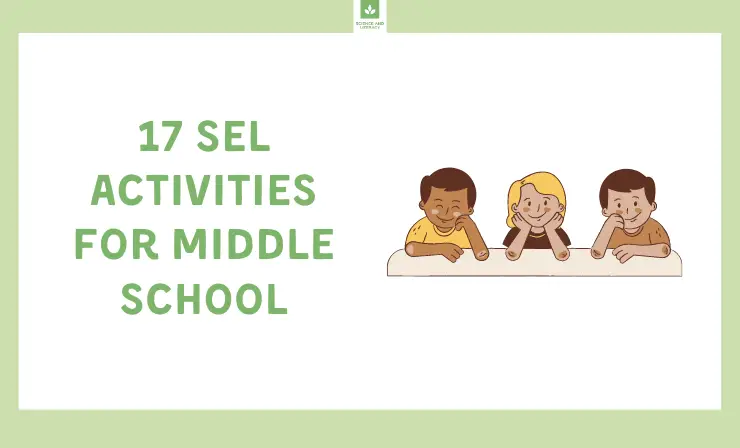
Stepping into the realm of social-emotional learning not only equips youngsters with indispensable tools to navigate treacherous terrains but also arms them with the prowess to adapt swiftly to new environments. Encouraging a growth mindset becomes second nature as they engage in these transformative activities. Moreover, fostering harmonious relationships, both within their peer group and beyond, becomes an art they effortlessly master.
Enthusiastic about weaving the fabric of social-emotional learning into the very fabric of your classroom or school? Prepare yourself for an all-encompassing, comprehensive guide that transcends conventional boundaries. This guide unravels the profound meaning and unrivaled significance of social-emotional learning, opening new avenues of understanding. Brace yourself for an extensive repertoire of SEL activities, meticulously tailored to cater to diverse age groups, ensuring that no student is left untouched by its powerful impact.
Get ready to embark on an odyssey of fun sel activities for middle school, where perplexity and burstiness converge to create an immersive experience for your middle schoolers. Together, let us forge a path towards holistic growth, paving the way for a future where emotional intelligence reigns supreme.
After reading this article, you’ll get to know about:
- What is social emotional learning? →
- Why is social emotional learning important? →
- Five core social emotional learning competencies→
- Art activities
- Goal-setting activities
- Icebreaker activities
- Journal writing
- Debating
- Quote of the day
- Student-led celebrations
- A goal-setting letter to yourself
- Close reading with Notice and Note
- Habit of a Learning Mindset
- “Think, Say, Do”
- Different Perspective Scenario
- Hurtful Words
- Complimenting
- Active Listening Inventory
- “My Bubble”
- Perseverance and Positive Self-Talk
What Is Social Emotional Learning?
Social emotional learning (SEL) is an intricately woven approach that transcends age boundaries, aiming to unravel the enigmatic depths of individuals’ emotional landscapes, while simultaneously beckoning them to embrace these profound sentiments with unyielding fervor.
This immersive journey of self-discovery converges with the essence of empathy, gently coaxing students of diverse backgrounds to traverse the labyrinthine corridors of their own intricate emotional tapestries. Armed with this newfound comprehension, they embark upon a quest to mold their decision-making processes into bastions of accountability, forging effective strategies to conquer the formidable peaks that adorn their personal horizons, all the while endeavoring to cultivate symbiotic connections with their peers that resonate with authenticity and meaning.
Enclosed within this concise video lies a wealth of knowledge pertaining to the intricate domain of social emotional learning (SEL).
Within the kaleidoscope of our contemporary world, where diversity reigns supreme, the hallowed halls of the classroom serve as an idyllic microcosm, encapsulating the myriad hues of humanity’s tapestry. It is within this sacred space that the edifice of social and emotional learning (SEL) endeavors to provide students with an eclectic arsenal of tools, transforming their educational odyssey into an egalitarian playing field, where every soul is bestowed with the opportunity to flourish. By kindling the flame of self-awareness, we bestow upon these nascent minds the priceless gift of introspection, enabling them to navigate the ebbs and flows of their own thoughts and emotions with an unshakable clarity.
Furthermore, the nurturing seeds of empathy, lovingly sown within the fertile soil of their hearts, sprout into tendrils that extend far beyond the confines of their immediate community, stretching their compassionate embrace to envelop the broader global tapestry that encompasses us all. It is through this holistic fusion of the self and the collective that students, like metamorphosing butterflies, emerge from the chrysalis of academia as multifaceted beings—capable, productive, self-aware, and imbued with an indomitable sense of social consciousness that shall guide them through the labyrinthine corridors of their future challenges, enabling them to soar to unprecedented heights.
Why Is Social Emotional Learning Important?
In today’s ever-evolving society, social emotional learning emerges as a paramount factor in preparing students for the intricacies of life beyond the classroom. Its influence extends far beyond the school gates, equipping learners with skills that remain applicable long after they bid farewell to their educational institutions. As the curtain rises on their learning journey, social emotional learning takes center stage, commanding attention and becoming an indispensable aspect of their holistic growth.
The empirical evidence supporting the integration of social emotional learning into educational frameworks is striking. Extensive research illuminates its profound impact on academic outcomes, especially for students hailing from diverse backgrounds. A thought-provoking meta-analysis conducted in 2011 unveiled a compelling truth: schools embracing high-quality social emotional learning programs experienced a remarkable average gain of 11% in academic achievement among their students.
But the benefits of social emotional learning go beyond mere academic success; they manifest in lasting dividends that reverberate throughout a lifetime. Investing in the development of social emotional skills yields substantial returns, creating a ripple effect that transcends the confines of the school environment. Astonishingly, schools that dedicate resources to robust social emotional learning initiatives witness an astounding average return of 11 dollars for every dollar invested, enriching both the school community and the wider society in immeasurable ways.
💡 Social Emotional Learning is only for kids with behaviour issues?
❌NOT TRUE! #socialemotionallearning #SEL #socialemotionalskills #selcourse pic.twitter.com/YnlQ4uirsw
— unesco_mgiep (@UNESCO_MGIEP) July 5, 2023
The transformative power of social emotional learning is most striking when nurtured from the earliest stages of a child’s education. A noteworthy study commissioned by the Organisation for Economic Co-operation and Development (OECD) unveiled an intriguing truth: equipping kindergarteners with basic social and emotional skills has far-reaching academic benefits. Even in high-poverty schools, the implementation of such strategies effectively closes achievement gaps, underscoring the pivotal role of early social emotional learning interventions.
The impact of strong social and emotional skills on students’ overall well-being and success cannot be understated. Those fortified with these skills radiate a multitude of positive attributes. Their engagement in learning soars, dropout rates dwindle, and behavioral issues diminish. Moreover, they exude a commendable level of confidence and self-esteem, laying a solid foundation for their journey towards personal and academic triumph.
In light of the far-reaching implications of social emotional learning, it becomes evident that implementing effective programs and activities in this domain holds the potential to touch the lives of countless students. By embracing and nurturing their social and emotional development, we empower them to navigate the complexities of the world with resilience, empathy, and unwavering determination.
Watch the video below to acquire valuable insights into the significance of social emotional learning in the present context.
5 Core Social Emotional Learning Competencies
In the realm of social emotional learning, there exist five fundamental competencies, carefully delineated by CASEL, that weave a tapestry of self-awareness, self-management, social awareness, relationship skills, and responsible decision-making.
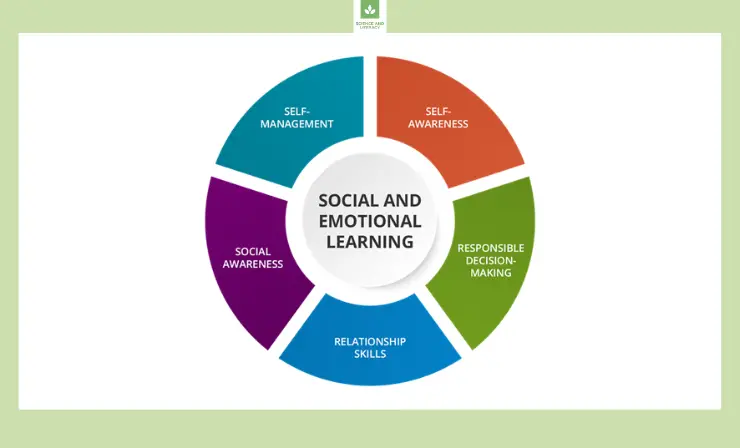
- Delving into the depths of self-awareness, individuals embark on an arduous journey of recognizing and comprehending the intricate nuances of their own emotions and thoughts. This self-exploration deluge navigates the labyrinth of introspection, unraveling the threads that connect cognition and behavior. Furthermore, self-awareness encompasses the art of assessing personal strengths and weaknesses, painting a vivid portrait of one’s internal landscape.
- Venturing into the terrain of self-management, one is beckoned to traverse the realm of mental and emotional regulation. The art of reigning in capricious thoughts and tempestuous emotions forms the bedrock of this competence. Equipped with the skillful art of goal-setting, the individual emerges as a captain of their own destiny, steering away from the treacherous cliffs of impulsive actions. Navigating the tumultuous seas of stress, one learns to anchor themselves, weathering the storms with resilience and preserving the sanctity of a positive mindset.
- Stepping into the realm of social awareness, one is transported to a kaleidoscope of perspectives and experiences. This empathic odyssey calls upon individuals to transcend the boundaries of their own existence and embrace the multifaceted tapestry of humanity. Genuine empathy, akin to a radiant sunbeam, illuminates the path towards meaningful relationships. Seeking solace and support within the tapestry of family, school, and community, one nurtures connections that transcend the superficial and foster genuine bonds.
- Mastering the art of relationship skills, individuals immerse themselves in a symphony of effective communication and collaboration. Skillful conduits of thoughts and emotions, they orchestrate harmonious melodies that resonate within the hearts of others. In the face of negative peer pressure, they stand tall, fortified by unwavering resolve, and extend helping hands to uplift those around them. The scaffolding of healthy relationships, woven with threads of respect, trust, and empathy, becomes the cornerstone upon which connections flourish.
- Finally, the journey culminates in the realm of responsible decision-making, a crucible of ethical discernment and sagacious choices. Adorned with the mantle of responsibility, individuals weigh the intricate tapestry of personal behavior and relationships. Deliberating upon the multifarious consequences that ripple through the fabric of existence, they exercise the sharpened blade of critical thinking to carve out paths that embody integrity and virtue.
Embracing these five ethereal competencies, social emotional learning weaves an intricate tapestry, unfurling its threads within the hearts and minds of students. Within this intricate tapestry lies a trove of invaluable skills and attitudes, fostering holistic well-being and sowing the seeds of triumph across the vast expanse of life’s myriad domains.
1. Art-Activities
Embarking on artistic expression can serve as an awe-inspiring conduit, allowing students to unleash their creativity, find solace amidst the chaos, and embark on a journey of self-discovery. Regardless of age, the realm of art offers a sanctuary for students to delve into their emotions, harnessing their power in a constructive and transformative manner.
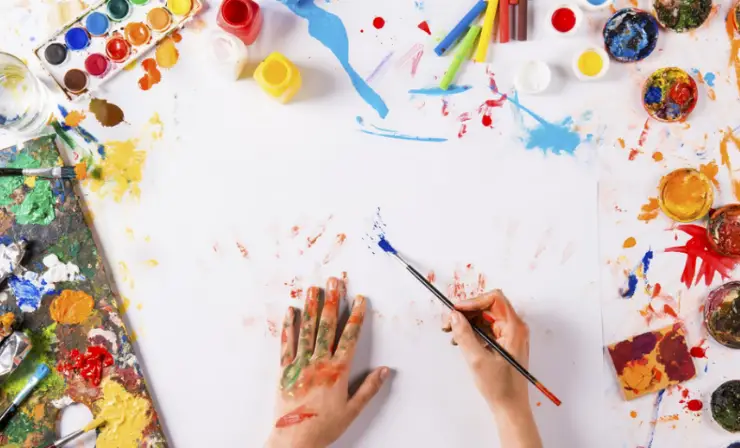
To embark on this artistic odyssey, gather a vibrant assortment of art supplies and prepare a captivating piece of music, a thought-provoking poem, or an engaging story. Present this masterpiece to your students, igniting their imagination and inviting them to immerse themselves in its essence. Encourage them to employ the tools at their disposal to create visual expressions that mirror their emotional responses to the chosen piece. As they delve into this creative endeavor, provide them with insightful prompts to guide their exploration:
- Unleash the emotions: How did the artistic creation make you feel? Dive into the depths of your being and unravel the emotional tapestry woven by this experience.
- Decipher the tones: Does the music exude an aura of jubilance or melancholy? Encourage your students to unravel the hues of the overall tone and mood, unraveling its connection to their own emotional landscape.
- Color your emotions: As the melodies caress their ears, ask your students to explore the kaleidoscope of colors that dances within their minds. What shades align with the emotions or ambiance conveyed by the piece?
Through this captivating art activity, students embark on a profound journey of self-awareness. They embrace the intricate dance of emotions, unraveling their innermost sentiments and finding solace in the visual tapestries they weave. By transmuting their emotions into tangible creations, they embark on a transformative voyage of self-expression, nurturing their artistic prowess and forging a deeper connection with their thoughts and feelings.
This video offers excellent examples of engaging art activities.
2. Goal-Setting Activities
In the tapestry of social emotional learning, the thread of self-management weaves a powerful narrative, empowering students to embrace growth mindsets and chart their paths to success. One of the most potent tools to achieve this is the art of goal setting.
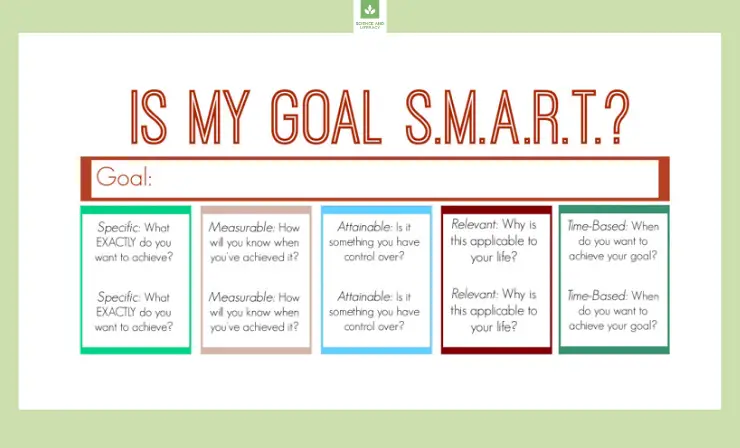
Infuse goal setting into the very fabric of your classroom routine, fostering a culture of proactive learners who shape their destinies. Embrace a multifaceted approach to weave goal setting into your pedagogical tapestry:
- Empower student-led conferences: Illuminate the path towards growth by orchestrating conferences that empower students to take the reins of their educational journeys. Nurture an environment where they actively participate in setting academic and behavioral goals, reflecting on their progress, and envisioning their future selves. These conferences become an empowering platform for students to identify areas for improvement and establish concrete targets to conquer.
- Embrace the dawn of a new unit: Harness the power of curiosity as students embark on a new unit of study. Unveil a captivating KWL (Know, Want to Know, Learned) chart, inviting them to explore the depths of their aspirations. Together, they set sail towards a destination teeming with knowledge and skills waiting to be unraveled. The act of setting goals becomes an essential part of their educational voyage, a compass guiding their growth and anchoring their purpose.
- Craft feedback as a catalyst for growth: As students pour their hearts into their projects, infuse feedback with the power to ignite their flames of improvement. Illuminate their accomplishments, shining a light on their strengths, while simultaneously guiding them towards areas where growth beckons. This intentional feedback process becomes a springboard for setting goals for future projects, helping students prioritize their focus and embark on a journey of continued development.
Through the practice of goal setting, students hone their self-management skills, becoming the captains of their own destiny. Armed with the power of SMART (Specific, Measurable, Attainable, Relevant, Time-Bound) goals, they embrace self-reflection, regulate their actions, and cultivate accountability. Time becomes their ally, as they master the art of managing their resources, efforts, and ambitions to forge their path towards success.
In this grand tapestry of self-management, journals and goal trackers emerge as indispensable tools, capturing the essence of aspirations, tracking progress, and offering a space for reflection. These personalized keepsakes become a testament to growth, visual reminders of the journey traveled and the milestones achieved. Through the embrace of goal setting, students awaken the dormant potential within, harnessing the power to sculpt their destinies and flourish as proactive learners in pursuit of their dreams.
This video can serve as a valuable resource for students to reflect upon their experiences of adapting or adjusting their goals and personal expectations.
3. Icebreaker Activities
Imagine a tapestry woven with threads of laughter, camaraderie, and self-discovery—an enchanting realm where students of all ages come together, sharing glimpses of their inner worlds within the safety of a warm and welcoming environment. Icebreaker activities, like a refreshing breeze on a summer day, create the perfect setting for students to embark on a journey of self-awareness and relationship building.
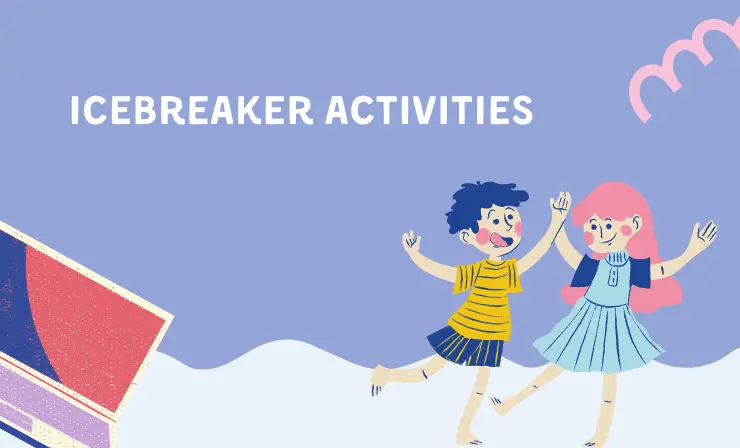
Let’s explore some captivating icebreaker activities that lay the foundation for self-awareness and relationship skills:
- “Two Truths and a Lie”: Unleash the storyteller within each student as they craft two true statements and one cleverly concocted falsehood about themselves. As classmates become detectives, their keen senses are put to the test to unravel the truth. Through this whimsical game, students engage in self-reflection, carefully selecting what aspects of their lives they wish to share and discovering the power of connection through playful deception.
- “All About Me Collage”: Watch as students transform art supplies into portals of self-expression, constructing vibrant collages that encapsulate the kaleidoscope of their identities. Hobbies, interests, and core values dance together on the canvas, revealing the essence of who they are. This introspective activity encourages students to reflect on their personal identities, fostering a deep sense of self-awareness while simultaneously providing an opportunity for their peers to gain insight into their unique journeys.
- “Pair Share”: In this enchanting dance of conversation, students are paired up, their stories interweaving in a symphony of connection. Each student takes turns sharing something distinctive about themselves with their partner, and the magic unfolds as they introduce their newfound confidant to the rest of the class. Active listening, empathy, and the building of authentic relationships take center stage, as students celebrate the beauty of each other’s narratives.
- “Goal Sharing Circle”: Gather students in a sacred circle, their dreams and aspirations lighting up the space like stars in the night sky. One by one, they share personal goals for the upcoming year, their voices resonating with hope and determination. In this powerful ritual, self-awareness is ignited, as students reflect on their own desires and ambitions, while relationship skills flourish as they find common ground or offer support for each other’s dreams.
Utilize this video as a comprehensive guide for conducting the Two Truths and a Lie activity.
4. Journal Writing
Amidst the pages of a journal lies a realm of infinite possibilities—a sanctuary where thoughts take flight, emotions find solace, and self-awareness blooms like a delicate flower. Unlocking the power of journal writing, middle school students embark on a transformative journey of self-discovery and introspection.

Carve out dedicated time each week, where students can immerse themselves in the realm of journaling. Offer them prompts that kindle the flames of self-awareness:
- Gratitude: Encourage students to pause and reflect on the treasures that grace their lives each day. Prompt them to explore what they are grateful for and delve into the profound impact gratitude has on their overall well-being.
- Self-care: Unlock the gateway to self-nourishment as students embark on an exploration of self-care. Prompt them to define what self-care means to them personally and guide them to ponder the activities or practices that replenish their spirits.
- Favorite hobby: Invite students to unleash their passions as they write about their favorite hobby. Encourage them to dive deep into the reasons behind their fondness, exploring the sparks that ignite their souls. This introspective prompt kindles self-reflection and unveils the essence of their unique interests.
- Confidence booster: Illuminate the power of relationships as students reflect on the person in their lives who fills them with confidence. Encourage them to delve into the qualities and support provided by that individual, unraveling the profound connection between positive relationships and self-esteem.
In this journaling journey, consider offering feedback and discussion on one or two entries that students choose to share with you, honoring their privacy while fostering growth and connection.
Journal writing becomes a sacred act of self-expression, allowing students to traverse the depths of their emotions, unravel the tapestry of their thoughts, and embrace the beauty of self-discovery. By infusing journaling into the classroom routine, students cultivate a profound understanding of themselves and their experiences, nurturing well-being, and illuminating the path towards personal growth.
Demonstration teachers Vanee Matsalia and Oana Matei graciously share their effective daily opening writing strategies employed in their middle school classes within this video.
5. Debating
The art of debate is a formidable tool that empowers middle school students to hone their skills in relationship building, self-management, and responsible decision-making. With a touch of preparation and a sprinkle of enthusiasm, debates become arenas where students learn to craft compelling arguments, listen actively, and engage in respectful disagreement.
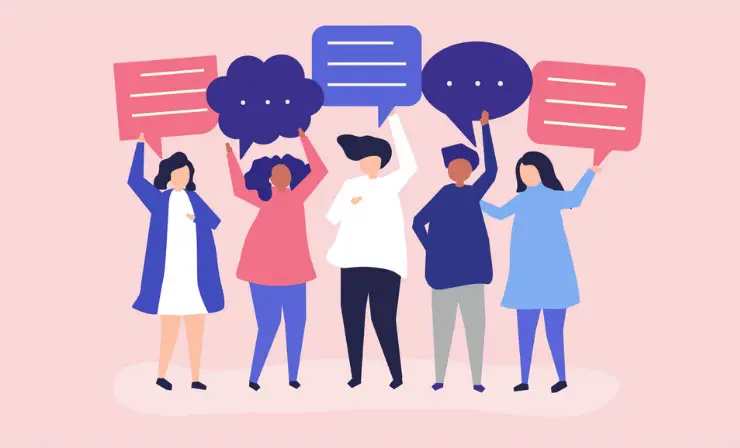
Let’s unravel the steps to seamlessly integrate debate into your lesson:
- Handpick a relevant debate topic: Choose a topic that resonates with your lesson content, igniting the flames of passion and curiosity within your students. Whether it’s dissecting the themes of a recently finished novel or delving into a current event intertwined with their studies, relevance ensures that students are fully engaged in the discussion.
- Divide and conquer: Split your students into teams, allowing them to collaborate with peers who may hold different perspectives. In this fertile ground of teamwork, students learn the art of cooperation, appreciating the beauty of diverse ideas and the transformative power of collective effort.
- Construct arguments with finesse: Guide students in crafting well-structured arguments that support their viewpoints. Teach them the art of research, empowering them to gather evidence that bolsters their cases. Emphasize the importance of respectful discourse, logical reasoning, and the use of credible sources to back up their claims.
- Respond with grace: Encourage active listening and cultivate an atmosphere of respectful disagreement during the debate. As students articulate their arguments, their peers should have the opportunity to respond, pose thoughtful questions, and present counterarguments. This exquisite dance of dialogue nurtures relationship skills such as effective communication, empathy, and the ability to embrace diverse perspectives.
- Polish the art of public speaking: Debates offer a mesmerizing stage for students to unleash their public speaking skills. Encourage them to deliver their arguments with confidence, employing persuasive language, and captivating the audience. Provide constructive feedback to guide them towards continuous improvement in their presentation skills.
Through the magic of debates, students flourish in relationship skills, learning to express their opinions respectfully, and engage in meaningful and thought-provoking conversations. Self-management takes center stage as students organize their thoughts, manage their time effectively, and remain focused during the debate. Responsible decision-making is elevated as students critically evaluate arguments, contemplate different viewpoints, and make informed choices based on evidence.
Debates serve as catalysts for dynamic and interactive learning experiences, enabling students to refine their SEL skills while delving deeper into the lesson material, forging connections, and embracing the beauty of diverse perspectives.
This video provides valuable insights into the art of debating and offers guidance on how to effectively conduct a debating activity.
6. Quote of the Day
In the realm of self-awareness and relationship skills, the humble quote emerges as a powerful tool, igniting sparks of introspection and fostering deep connections among students.
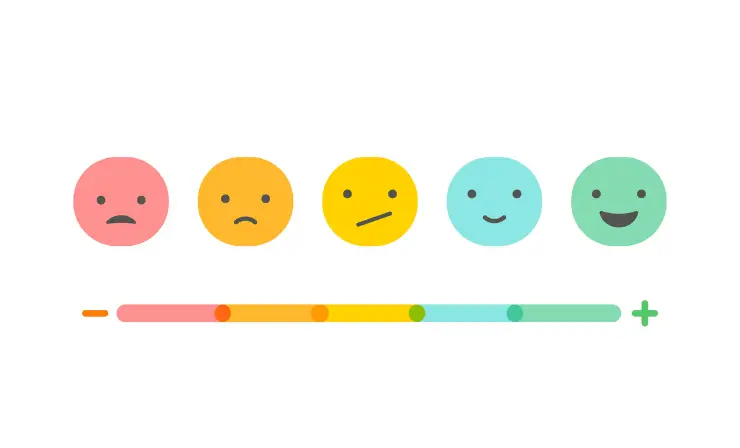
Let’s unravel the steps to engage students in reflection and critical thinking through the use of relevant quotes:
- Curate a captivating quote: Select a quote that resonates with the topic or issue under discussion. Consider using teacher quotes that touch upon important themes or evoke a sense of familiarity and shared experiences.
- Display the brilliance: Present the chosen quote prominently, whether through writing it on the board or displaying it in a visually appealing manner. Make sure it captures the attention of students, becoming an inviting portal to contemplation.
- Prompt an emotional analysis: Encourage students to delve into the emotions the speaker of the quote may be experiencing. Pose questions that inspire empathetic exploration: What emotions do you think the speaker is expressing? How can you infer those emotions from the words in the quote? Through this exercise, students develop the invaluable skill of putting themselves in the speaker’s shoes.
- Explore personal emotional responses: Invite students to embark on a personal journey of introspection, reflecting on their own emotional reactions to the quote. Prompt them to ponder: What emotions does this quote evoke within you? Why do you think you feel this way? Encourage them to express their emotions authentically, fostering self-awareness and reflection.
- Delve into the context and worldview: Initiate a lively discussion or provide journaling prompts that delve into the background information and worldview the speaker may be referencing in the quote. Encourage students to analyze the speaker’s perspective, contextual factors, and potential influences on their viewpoint. This exercise nurtures critical thinking and nurtures an understanding of diverse perspectives.
These steps can be implemented through small group discussions, individual journaling responses, or whole-class conversations. Each approach offers an opportunity for students to engage with the quote, analyze their emotions, and cultivate empathy and critical thinking skills.
By utilizing quotes as prompts for reflection and discussion, students deepen their self-awareness, practice empathy, and enhance their understanding of different worldviews. These activities foster positive relationships in the classroom, nurturing a sense of connection and understanding among students that enriches their SEL journey.
This video serves as an invaluable guide on how to facilitate a discussion centered around the given quote.
7. Student-Led Celebrations
Transforming a classroom party into a remarkable learning experience, where students take the reins and showcase their social awareness, relationship skills, and responsible decision-making, creates an environment teeming with growth and camaraderie. By embarking on this journey of student-led celebrations, they embark on a transformative path, embracing skills such as responsibility, budgeting, time management, and the power of teamwork.

Let’s delve into the steps that guide them towards success:
- Establish expectations through a rubric: Present students with a rubric that outlines the key aspects of the party planning process. From selecting a theme to creating invitations, scheduling, decoration, and organizing setup and cleanup, this rubric becomes their compass, nurturing responsible decision-making and providing a clear roadmap.
- Navigate time constraints and budget: Introduce students to the concept of time constraints, urging them to manage their precious minutes with grace and efficiency. Even if the budget is minimal or nonexistent, encourage them to make thoughtful decisions within the given resources. This exercise in responsible decision-making sets the stage for their journey of growth.
- Champion the power of collaboration: Unleash the potential of teamwork as students join forces, intertwining their talents and skills to plan and execute the grand celebration. This collaboration fosters relationship skills such as effective communication, cooperation, and problem-solving. By assigning roles, delegating tasks, and embracing the art of effective teamwork, students witness firsthand the transformative power of collective effort.
- Theme selection and invitation creation: Awaken their creativity as they brainstorm and select a captivating theme that resonates with the entire class. Through this process, students practice social awareness, considering the preferences and interests of their peers. They then embark on the enchanting task of designing and creating invitations that reflect the chosen theme, evoking anticipation and excitement.
- Scheduling and activity planning: Empower students to navigate the intricacies of scheduling, working collaboratively to determine the ideal date and time for the celebration. Their social awareness shines as they consider the availability and preferences of the class. Additionally, they explore their creativity by planning engaging activities that cater to the interests and abilities of all students, creating an inclusive and enjoyable experience for everyone involved.
- Decoration and setup/cleanup organization: Witness their artistic prowess as students infuse the classroom with a vibrant tapestry of decorations that breathe life into the chosen theme. This creative endeavor fosters responsibility and accountability as they coordinate setup and cleanup responsibilities, ensuring a seamless and harmonious transition throughout the celebration.
Throughout the process, offer examples and guidance to support students as they navigate the various aspects of party planning. Encourage them to think creatively, respect diverse opinions, and make responsible choices that consider the well-being and enjoyment of the entire class.
By embarking on the adventure of student-led celebrations, students develop social awareness, strengthen relationships, and practice responsible decision-making while savoring the joy and magic of a memorable event that they have created with their own hands.
This video serves as a prime illustration highlighting the significance of teamwork.
8. A Goal-Setting Letter to Yourself
Within the realm of self-management, a profound journey unfolds, one that empowers students to focus on their strengths, set meaningful goals, and cultivate the self-motivation and self-discipline necessary for their personal and academic success. The art of goal-setting becomes a beacon of inspiration, guiding them towards new horizons and nurturing their innate potential.
The Carmen Sandiego Fearless Kids web series presents a valuable resource, a lesson plan titled “Write a Goal-Setting Letter To Yourself” that illuminates the path to self-management mastery. Through this enlightening lesson plan, students embark on an introspective voyage, embracing their aspirations, and charting a course towards personal growth and fulfillment.
By engaging in goal-setting activities, students unlock the doors of achievement and motivation. As they witness their progress and growth, a sense of fulfillment blossoms within them. Through self-reflection, the celebration of their strengths, and the development of strategies to overcome obstacles, their self-confidence and resilience are fortified. Implementing the provided lesson plan grants students an active role in their own journey of self-discovery and personal growth.
By emphasizing the significance of self-management and offering students the tools to set and pursue their goals, we empower them to navigate the challenges of life with determination and a positive outlook. They embrace the responsibility of shaping their own destiny, propelling themselves towards success and self-assuredness.
This video is an excellent resource that can be utilized to engage and educate students on the topic of goal setting.
9. Close Reading With Notice and Note
In the tapestry of life, social awareness threads connect us to the diverse experiences and perspectives of others. Through the powerful lens of close reading, students embark on a transformative journey of empathy and understanding. The Notice & Note social-emotional activity for middle school emerges as a beacon, weaving together insights from the novel A Long Walk to Water, fostering social awareness and nurturing compassion.

Here’s how this activity unfolds:
- Step into the world of close reading: Students immerse themselves in carefully selected excerpts from A Long Walk to Water, focusing on passages that shed light on Salva’s arduous journey. Through close reading, they analyze the text, uncovering essential details and exploring the themes that shape Salva’s narrative.
- Unveiling diverse perspectives: As students delve deeper into the text, they encounter a spectrum of perspectives, stepping into Salva’s shoes as a Sudanese refugee. They grapple with challenging questions and hardships, cultivating critical thinking skills and embracing the beauty of multiple viewpoints.
- The birth of empathy: Salva’s story becomes a wellspring of empathy, as students connect with his experiences and emotions. They walk alongside him, feeling the weight of his struggles, and in doing so, develop a profound understanding of the challenges he faces. Empathy flourishes, fostering a sense of compassion and appreciation for the richness of diverse experiences.
- Reflection and dialogue: The close reading experience paves the way for reflection and meaningful discussion. Students share their thoughts, emotions, and insights, articulating their understanding of Salva’s perspective. Guided conversations kindle the flames of empathy, respect, and diversity, fostering a classroom community built on empathy and understanding.
By engaging in this transformative Notice & Note social-emotional activity, students deepen their understanding of diverse perspectives and enhance their social awareness. They learn to embrace diversity, respect others, and cultivate empathy, enriching their journey towards becoming compassionate and inclusive citizens of the world.
In this video, Caroline provides a detailed overview of close reading, explaining its concept and demonstrating how students can effectively employ close reading skills to tackle reading comprehension passages.
10. Habit of a Learning Mindset
In the tapestry of self-awareness, the threads of growth mindset weave a remarkable journey of self-improvement. The “Habits of a Learning Mindset” poster illuminates this path, nurturing self-awareness and empowering students with the belief in their own potential.
Unfurl the poster in your classroom or on your virtual learning platform, serving as a daily reminder of the qualities that embody a learning mindset. Each day, select a quality from the poster, inviting students to share personal examples that resonate with their own experiences. For instance, exploring the quality of perseverance, students reflect on a time when they learned from a mistake and persevered.
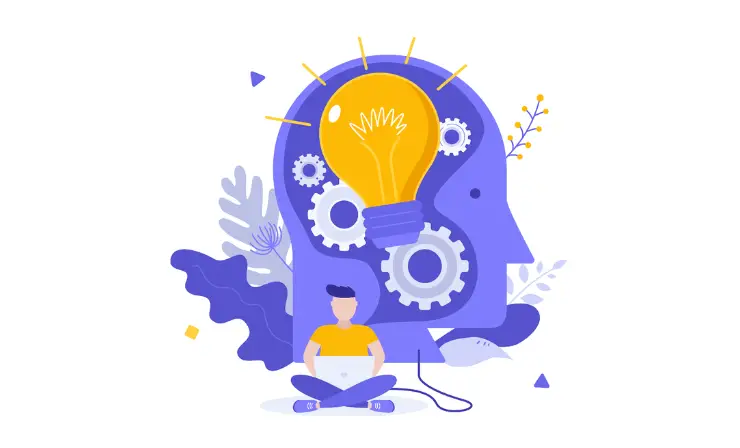
The 12 qualities etched within the learning mindset poster become catalysts for a “can-do” attitude, infusing students with a sense of positivity. Engaging in regular discussions and reflections, students deepen their self-awareness, unraveling their unique strengths and areas for growth. They become attuned to the mindset and behaviors that propel them towards success and well-being.
In these conversations, students share personal stories, draw inspiration from their peers, and unlock valuable insights into the application of a growth mindset in various contexts. Self-reflection blooms, cultivating critical thinking skills and nurturing a sense of collective support within the classroom.
Through the integration of the learning mindset poster and the accompanying discussions, students are emboldened to embrace a growth mindset, to embrace challenges, and to persevere in the face of setbacks. They cultivate the self-awareness necessary for personal growth and foster the unwavering belief in their ability to continuously improve and achieve their goals.
To help students understand the distinction between Growth Mindset and Fixed Mindset, you can utilize this video as a valuable resource. It offers clear explanations and examples that can promote their comprehension of these two concepts.
11. “Think, Say, Do”
In the symphony of self-awareness, the “Think, Say, Do” activity emerges as a harmonious melody, guiding tweens and teens towards effective anxiety and stress management. Rooted in the power of positive self-talk and proactive action, this activity empowers students to transform their negative thoughts into affirmations of resilience. To amplify the impact, the activity can be extended through a gallery walk, where students provide feedback and support to one another.
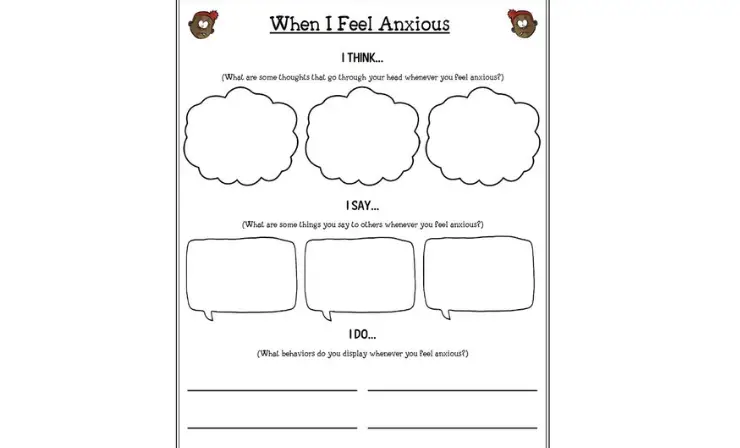
Let’s explore how to implement the “Think, Say, Do” activity:
- Introduce the purpose: Set the stage by explaining the objective of the activity—to empower students to address anxiety and stress constructively. Emphasize the transformative power of positive self-talk and the importance of proactive steps in managing emotions effectively.
- Identify triggers: Encourage students to reflect on their experiences and identify the thoughts or situations that trigger anxiety or stress. Each student should jot down these triggers on individual sheets of paper.
- Harness the power of positive self-talk: Guide students to reframe their negative thoughts into positive self-talk. For each trigger, they should craft a positive affirmation that counters the negativity. This step cultivates self-awareness and equips students with the tools to shift their mindset towards positivity.
- Embrace proactive actions: Building on the foundation of positive self-talk, encourage students to identify actionable steps they can take to address their anxiety or stress. These actions should be practical and within their control. Students can draw upon strategies that have worked for them in the past or seek support from trusted individuals.
- Gallery walk and feedback: Arrange a gallery walk, where students showcase their thoughts, positive self-talk, and actionable steps. Display their sheets of paper around the classroom, inviting classmates to provide feedback, suggestions, and support. This collaborative activity nurtures empathy, relationship skills, and a collective sense of support within the classroom.
Through the “Think, Say, Do” activity, students develop self-awareness, hone the art of positive self-talk, and learn to navigate anxiety and stress through proactive measures. Moreover, this activity fosters a supportive classroom environment, where students can offer feedback, encouragement, and empathy to their peers. By equipping tweens and teens with these essential skills, we empower them to manage their emotions, build resilience, and thrive in the face of challenges.
The video lesson instructs students to pause, reflect, and take action. This activity bears resemblance to the Think, Say, Do approach, emphasizing thoughtful consideration before engaging in actions or expressions.
12. Different Perspective Scenario
In the tapestry of social awareness, the “Different Perspective Scenario” activity adds vibrant threads of empathy and perspective-taking. This captivating class lesson invites students to explore various situations, igniting their curiosity about the diverse responses that arise from unique perspectives.

Here’s how to bring the “Different Perspective Scenario” to life:
- Introduce the power of perspective: Begin by discussing the significance of understanding different perspectives in effective communication and cultivating empathy. Encourage students to consider how individual beliefs, experiences, and backgrounds shape their perceptions and responses to various situations.
- Select captivating scenarios: Handpick scenarios that resonate with the students’ lives or align with the topics being covered in class. These scenarios should encompass diverse social situations or conflicts, providing a fertile ground for the emergence of different perspectives.
- Unveil the scenarios: Present each scenario to the class, sharing sufficient details for students to grasp the context and the individuals involved. Ensure that the scenarios reflect diversity, representing a wide range of perspectives and experiences.
- Analyze the kaleidoscope of perspectives: Divide the class into small groups or pairs, assigning each group or pair a scenario to explore. Encourage students to delve into the feelings, thoughts, and reactions that each person in the scenario might have based on their unique perspective. Guide them to consider the factors that influence these responses, such as cultural background, personal beliefs, or past experiences.
- Share and enrich the tapestry: Bring the groups or pairs back together, giving each the opportunity to share their analysis of the scenario and the perspectives they explored. Facilitate a class discussion, creating a space for students to articulate their thoughts, compare diverse perspectives, and explore the potential impact of understanding and appreciating differing viewpoints.
Through the “Different Perspective Scenario” sel activity for middle school, students develop vital social skills, including perspective-taking, empathy, and understanding. They learn to embrace the beauty of diverse responses and interpretations that arise from different perspectives, fostering respect and appreciation for the tapestry of diversity. This lesson cultivates open-mindedness, effective communication, and the ability to navigate social situations with empathy and understanding.
This social skills training video effectively teaches the concept of empathy by encouraging students to imagine themselves in someone else’s position. It also offers practical examples to illustrate this important skill.
13. Hurtful Words
The “Hurtful Words” activity brings awareness to the impact of words and promotes discussions on empathy and responsible communication. It helps students understand that even unintentional words can cause harm to others.

Here’s how you can conduct the activity:
- Introduce the topic: Start by discussing the power of words and how they can have a lasting impact on people’s feelings and well-being. Emphasize that sometimes hurtful words can be said without intention, but it’s essential to be mindful of our language and its potential consequences.
- Reflect on personal experiences: Prompt students to reflect on times when someone has said something hurtful to them or when they have unintentionally hurt someone else with their words. Encourage them to write about these experiences in a personal journal or on a piece of paper.
- Sharing and discussion: Provide a safe and supportive environment for students to share their experiences if they feel comfortable doing so. Encourage active listening and empathy among the students as they listen to each other’s stories. After each sharing, initiate a discussion about the impact of those words, how they made the speaker or recipient feel, and possible ways to address such situations in the future.
- Reflection and follow-up discussion: Facilitate a larger class discussion to delve deeper into the power of words, exploring topics such as responsible communication, empathy, and the importance of thinking before speaking. Encourage students to consider alternative ways to express themselves without causing harm. Discuss strategies for resolving conflicts and promoting a positive and inclusive classroom environment.
By engaging in the “Hurtful Words” activity, students develop an understanding of the impact their words can have on others. They learn to exercise empathy, consider the consequences of their communication, and work towards fostering a culture of respect and kindness. This activity promotes responsible communication and encourages students to think critically about the power of their words, cultivating a more empathetic and supportive classroom community.
This video can be presented to students as a poignant illustration of how hurtful words can deeply impact others.
14. Complimenting
The “Complimenting” sel activity for middle school is a valuable group exercise that allows students to give and receive compliments. Through this activity, students will learn about the qualities of a meaningful compliment and how to graciously receive one. It provides an opportunity for students to practice giving compliments and fostering a positive and supportive classroom environment.

Here’s how you can conduct the activity:
- Discuss the importance of compliments: Begin by having a class discussion on the significance of compliments and their impact on individuals’ self-esteem and overall well-being. Explain that a genuine compliment has the power to uplift and inspire others.
- Explore qualities of a quality compliment: Facilitate a brainstorming session with the students to identify the characteristics of a quality compliment. Encourage them to consider aspects such as specificity, sincerity, and focusing on personal attributes or achievements.
- Model giving and receiving compliments: Demonstrate giving and receiving compliments by providing examples. Model how to express a thoughtful and genuine compliment, and demonstrate how to respond graciously when receiving a compliment. Encourage active listening and genuine appreciation during the demonstration.
- Pair or group students: Divide students into pairs or small groups, ensuring a supportive and inclusive environment. Instruct them to take turns giving compliments to each other. Encourage them to utilize the qualities of a quality compliment discussed earlier.
- Share peer compliments: Provide an opportunity for students to share the compliments they received from their peers. This can be done in pairs, small groups, or in a whole-class setting, depending on the classroom dynamics and time available. Encourage students to actively listen and appreciate the kind words shared by their classmates.
- Reflection and discussion: Facilitate a reflective discussion where students can share their experiences and the impact the compliments had on them. Discuss the positive atmosphere created by giving and receiving compliments and encourage students to continue uplifting and supporting each other.
By engaging in the “Complimenting” activity, students learn the art of giving genuine compliments and the value of receiving them with grace. This exercise promotes empathy, positive communication, and the building of supportive relationships among peers. It cultivates a classroom environment where students feel appreciated and encouraged, fostering a sense of belonging and well-being.
The video offers practical guidance and examples that aid in comprehending the importance of genuine and uplifting feedback.
15. Active Listening Inventory
Behold the realm of social-emotional learning (SEL) skills, where relationship skills reign supreme. In this enchanting journey, we shall explore the elusive “Active Listening Inventory,” an invaluable tool for self-evaluation of one’s auditory acumen. Brace yourself for a transformative experience that illuminates the significance of active listening, transcending the boundaries of both life and academia.
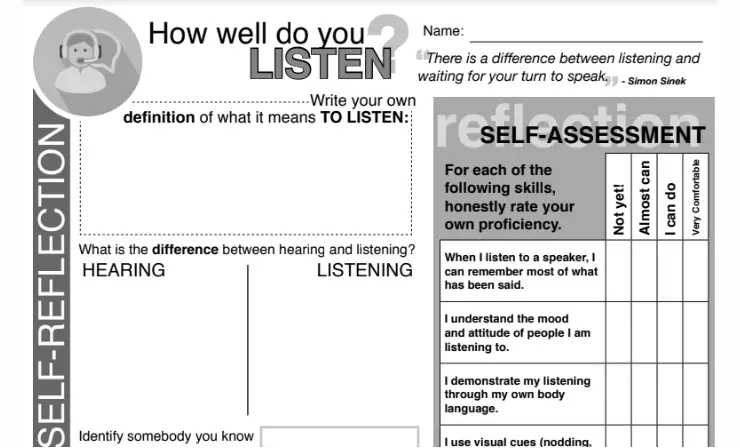
The realms of hearing versus listening:
- Initiating the Quest for Active Listening: As we set sail, it is imperative to decipher the nuances between mere auditory reception and the profound art of active listening. Pay homage to the depths of engagement, understanding, and appropriate responses that define active listening in its resplendent glory.
- Unveiling the Sacred Scrolls: Lo and behold! Unleash the Active Listening Inventory, a sacred scroll containing a self-assessment questionnaire adorned with statements delving into the realm of active listening prowess. Peer into its sacred contents, exploring the domains of unwavering eye contact, unwavering focus, inquisitive clarifications, and the symphony of verbal and non-verbal feedback.
- Delving into the Depths: With quill in hand, students shall meticulously peruse each statement, embarking upon a quest to unveil their own auditory abilities. On a scale that spans from the humble 1 to the lofty 5, they shall render judgment upon themselves, confessing the frequency with which they manifest each behavior.
- Pondering and Puzzling: Once the self-assessment draws to a close, a moment of contemplation awaits. Inquire into the depths of their scores, beckoning introspection and fostering an open mind. Encourage students to unearth the realms in which their active listening prowess flourishes and unearth those areas that yearn for improvement.
- Dialogue and Discourse: Gather the cohorts in a grand symposium, a conclave of enlightened minds. The self-assessment debrief shall commence, allowing students to share their profound insights and revelations. Delve into the profound implications of active listening, unraveling its significance in both scholarly pursuits and personal interactions. Conjure forth a tempest of strategies, weaving a tapestry of techniques to hone this vital skill—sustained eye contact, artful paraphrasing, and banishing the demons of distraction.
- The Blueprint for Mastery: Guide these aspiring listeners as they forge their own path towards greatness. Facilitate the creation of an action plan, wherein students craft meticulous goals and unveil strategies to cultivate their active listening prowess. The crucible of transformation may entail practicing this art during classroom discussions, seeking wisdom from peers, or even infusing it into the very fabric of their lives.
- The Blossoming of Acumen: Behold the fruits of this voyage, as students embrace the profound wisdom bestowed by the “Active Listening Inventory” activity. Witness their self-awareness blossom, the very essence of effective communication take root, and their ability to engage with knowledge and ideas flourish. Through the cultivation of active listening skills, they shall emerge as vigilant sentinels, compassionate souls, and triumphant seekers of scholarly and personal achievements.
Armed with the wisdom bestowed upon them, these enlightened beings shall traverse the corridors of existence, their senses heightened, their hearts open, and their ears attuned to the symphony of life. Let the “Active Listening Inventory” guide their steps as they embark on a lifelong odyssey, embracing the power of active listening to shape their destiny and illuminate their path.
The following video highlights the significance of listening skills and provides several recommendations to enhance this important skill.
16. “My Bubble”
Join us as we navigate the empyreal waves of this activity, exploring the profound realm of self-awareness and personal growth. In the tranquil waters of “My Bubble,” anchored in the wisdom of personal space and boundaries, students embark on a transformative journey towards emotional maturity. With the inclusion of sel activities in middle school, this captivating worksheet grants students a glimpse into the ethereal domain of personal bubbles, empowering them to assert their boundaries with unyielding might.
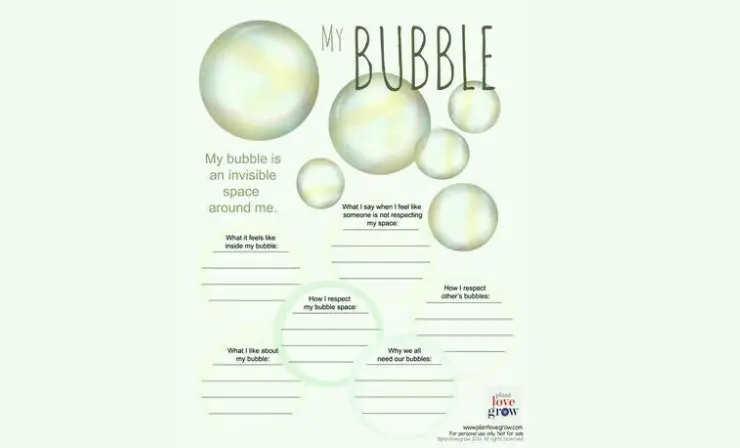
Let us embark on this voyage of self-discovery and embark on a path of emotional growth together.
- Embark upon this grand voyage by delving deep into the annals of personal space and boundaries. Enlighten students regarding the reverberating significance of personal boundaries in the realm of emotional well-being, emphasizing the need to honor not only their own boundaries but also those of others. A symphony of understanding takes shape, paving the way for harmonious interactions.
- As we traverse the realm of “My Bubble,” we beckon each student to embark on a journey of introspection. Distribute the sacred scrolls—the “My Bubble” worksheets—each adorned with a visual representation of the elusive bubble. Students find themselves in a sacred realm wherein they can visually manifest their personal space and boundaries, evoking the deepest realms of their consciousness.
- Within this realm of self-reflection and boundary setting, students plunge into a tapestry of thoughts. Engaging in profound introspection, they explore the facets that bestow comfort or unease upon their beings, delving into the intricate nuances of physical and emotional proximity. With pencil and ink as their guides, they breathe life into their boundaries, crafting a testament to their individuality and illuminating how they yearn for others to honor their sacred space.
- Behold the power of collective wisdom as students convene, engaging in a spirited discourse that traverses the realms of personal boundaries. Within the tapestry of conversation, their thoughts, experiences, and insights weave together, painting a vivid mural that explores personal space from myriad perspectives. The clarion call for open communication and the sanctity of consent resounds, nurturing an environment where personal boundaries flourish.
And as the crescendo nears, each student pens their empowering affirmations, their pens dancing upon the hallowed parchment. These affirmations, etched with the ink of empowerment, mirror their desire to safeguard their personal boundaries. Be it within the confines of the worksheet or upon separate cards, the resolute cadence of their declarations resounds—a testament to their rights, their agency, and their unwavering commitment to hold others accountable to the sanctity of their boundaries.
Witness the transformative power of the “My Bubble” activity as students delve into the enigma of personal space and boundaries. Here, they embark upon a voyage that unearths a profound understanding of self, while nurturing theseeds of empathy and respect. Within the nurturing confines of the classroom, this activity bestows upon students the gift of self-advocacy, fostering an inclusive and supportive environment. Empowered by the knowledge of their own boundaries, students emerge as champions of emotional well-being, their relationships flourishing with newfound understanding and reverence for personal sanctity.
Video can be utilized to support the development of self-management competency. It consists of a scenario followed by three reflection questions, which encourage individuals to assess and improve their self-management skills.
17. Perseverance and Positive Self-Talk
In the realm of self-awareness, where the echoes of individual triumph resonate, the virtues of perseverance and positive self-talk shine as beacons of hope. For middle schoolers navigating the tumultuous seas of growth, these invaluable skills become catalysts for transformation.
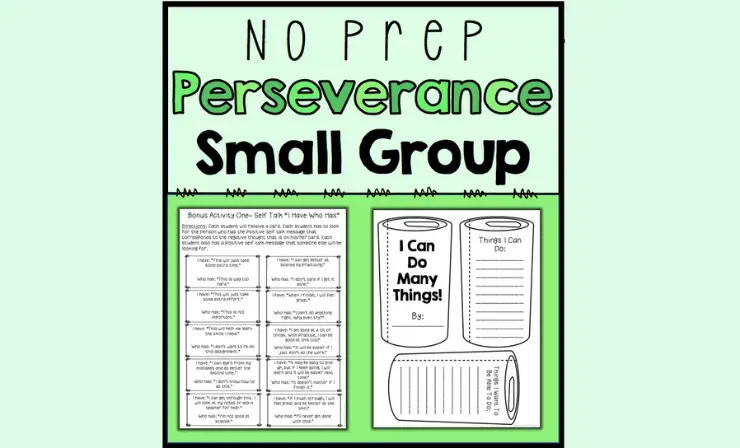
Amidst the ebb and flow of academic rigors, we unleash the power of a captivating game—the resplendent “I Have, Who Has.” Through this interactive journey, students shall bask in the warmth of positive self-talk, unraveling the tapestry of resilience and perseverance. Join us as we embark upon this extraordinary odyssey:
- Behold the birth of the majestic “I Have, Who Has” cards, adorned with the radiant hues of positive self-talk. These sacred vessels carry affirmations that ignite the embers of resilience and perseverance within young hearts. Each card, a testament to the power of belief, bears statements such as “I can overcome challenges,” “I am capable of learning and growing,” or “I believe in myself.”
- The game commences, setting the stage for a harmonious symphony of engagement. In a grand circle, students stand or sit, their hearts alight with anticipation. A card is bestowed upon each participant, and with a resolute voice, one student unveils their positive self-talk statement. The dance of words begins, with each participant who holds the matching affirmation responding, their voices intertwining in a mellifluous exchange. The game unfolds, cards passing hands, affirmations resonating, and minds embracing the transformative power of positive self-talk.
- As the game reaches its crescendo, a tapestry of thoughts unfurls within the classroom’s sacred walls. The collective wisdom of students converges, celebrating the significance of positive self-talk and its profound impact on resilience and perseverance. Reflection takes hold as students contemplate the affirmations they heard during the game, grasping the profound implications of these empowering statements. They immerse themselves in the realization that positive self-talk is a catalyst, igniting the flames of determination and fortitude.
- And now, as the final notes reverberate through the air, students embark upon a journey of introspection. They traverse the landscapes of their own thoughts, contemplating the myriad situations where positive self-talk can be an unwavering companion. Amidst the intricate tapestry of academic endeavors, sports challenges, and personal triumphs, they discern the power of positive affirmations as armor against adversity.
Witness the transformative power of the “I Have, Who Has” game, where positive self-talk thrives. Students, emboldened by the flames of resilience and perseverance, emerge as architects of their own destinies. Within the supportive embrace of the classroom, a growth mindset takes root, nurturing a vibrant tapestry of encouragement and support. Armed with the art of positive self-talk, students tread the path of triumph, their hearts aflame with the belief that they are capable of overcoming any obstacle that comes their way.
This video provides a comprehensive explanation of positive self-talk and showcases several examples to illustrate its practical application.
Additional Resources
- A collection of SEL lessons for middle school students that can be adapted for online learning
- The importance of SEL in schools
- Middle school students and their various personalities
Conclusion
Enhance students’ well-being and accomplishments with SEL activities for middle school students. Foster self-awareness, empathy, and responsible communication. Employ diverse methodologies like art, journaling, debates, and perspective-taking. Prioritize SEL to empower students to navigate challenges, embrace perspectives, and make a positive impact. Download the SEL activities for middle school PDF for inclusive classroom environments.
- Overview of 22 Low-Code Agencies for MVP, Web, or Mobile App Development - October 23, 2024
- Tips to Inspire Your Young Child to Pursue a Career in Nursing - July 24, 2024
- How Parents Can Advocate for Their Children’s Journey into Forensic Nursing - July 24, 2024

